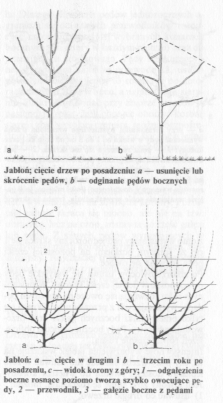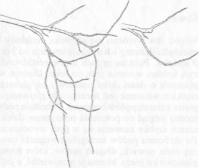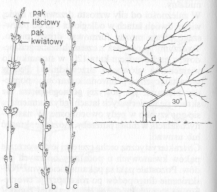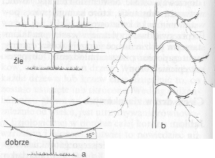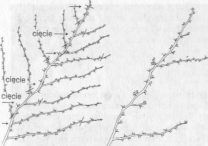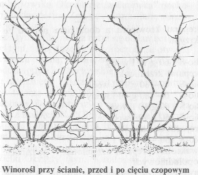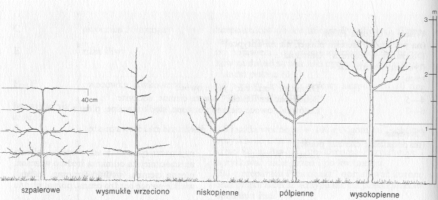Ojczyzną tego najważniejszego gatunku wśród drzew ziarnkowych jest Kaukaz. Gatunki dziko rosnące wykorzystywane są tylko jako podkładki. Pokrój drzewa w sadzie powinien być dziełem szkółkarza.
Drzewa posadzone jesienią dzięki ściółkowaniu gleby już w zimie tworzą młode korzenie, w związku z czym szybciej rozpoczynają wzrost na wiosnę niż drzewka sadzone wiosną. Rysunek obrazuje sposób wiosennego formowania koron. W pierwszym piętrze zostawia się trzy silne pędy. Zawsze należy pamiętać o usunięciu na obrączkę tzw. pędu konkurencyjnego, wyrastającego obok przewodnika. Pozostałe pędy jednoroczne można bez skracania odgiąć do położenia poziomego, dzięki czemu już w pierwszym roku wytworzą one pąki kwiatowe. Drugi rysunek obrazuje sposób cięcia w drugim i trzecim roku po posadzeniu. Na pędach rosnących poziomo wyrastający pęd jednoroczny skraca się 1 cm za śpiącym oczkiem; na pozostałej części pędu rozwiną się owoce.
Po zbiorze owoców usuwa się wszystkie pędy owoconośne w dolnej części korony. W następnym roku rozwijają się owoce na bocznych pędach, wyrastających z przewodnika. Skraca się tylko przewodniki bocznych gałęzi oraz przewodnik właściwy. Pędy boczne owocują obficie, jeżeli równocześnie rosną.
Intensywność wybarwienia jabłek wskazuje na to, czy pędy trzeba skracać lub usuwać w celu lepszego dostępu światła do wnętrza korony. Jeśli korony zbyt silnie się rozrastają, można:
1) usuwać co drugie drzewo;
2) uformować koronę na kształt wrzeciona;
3) stosować sposoby hamujące przepływ soków w pniu drzewa. Wydajność drzewa jest optymalna, gdy jego korona stanowi 80% zajmowanej przez drzewo przestrzeni. Przy odległościach drzew wynoszących 5 m średnica koron nie powinna być większe niż 4 m. Przeformowanie korony nie ogranicza się tylko do jabłoni i grusz na podkładkach słabo rosnących. Ten sposób można stosować z powodzeniem u wszystkich typów drzew, jak również na bocznych gałęziach starych drzew piennych. Takie cięcie można łatwo wykonać, jeśli się przestrzega zasady stałej wymiany pędów jedno-, dwu- i trzyletnich, przy czym najstarsze zawsze są w dolnej części korony lub gałęzi. Niekiedy praktykowane wstawianie w pień ograniczników przepływu soków wymaga specjalnych wiadomości i dużego doświadczenia.
